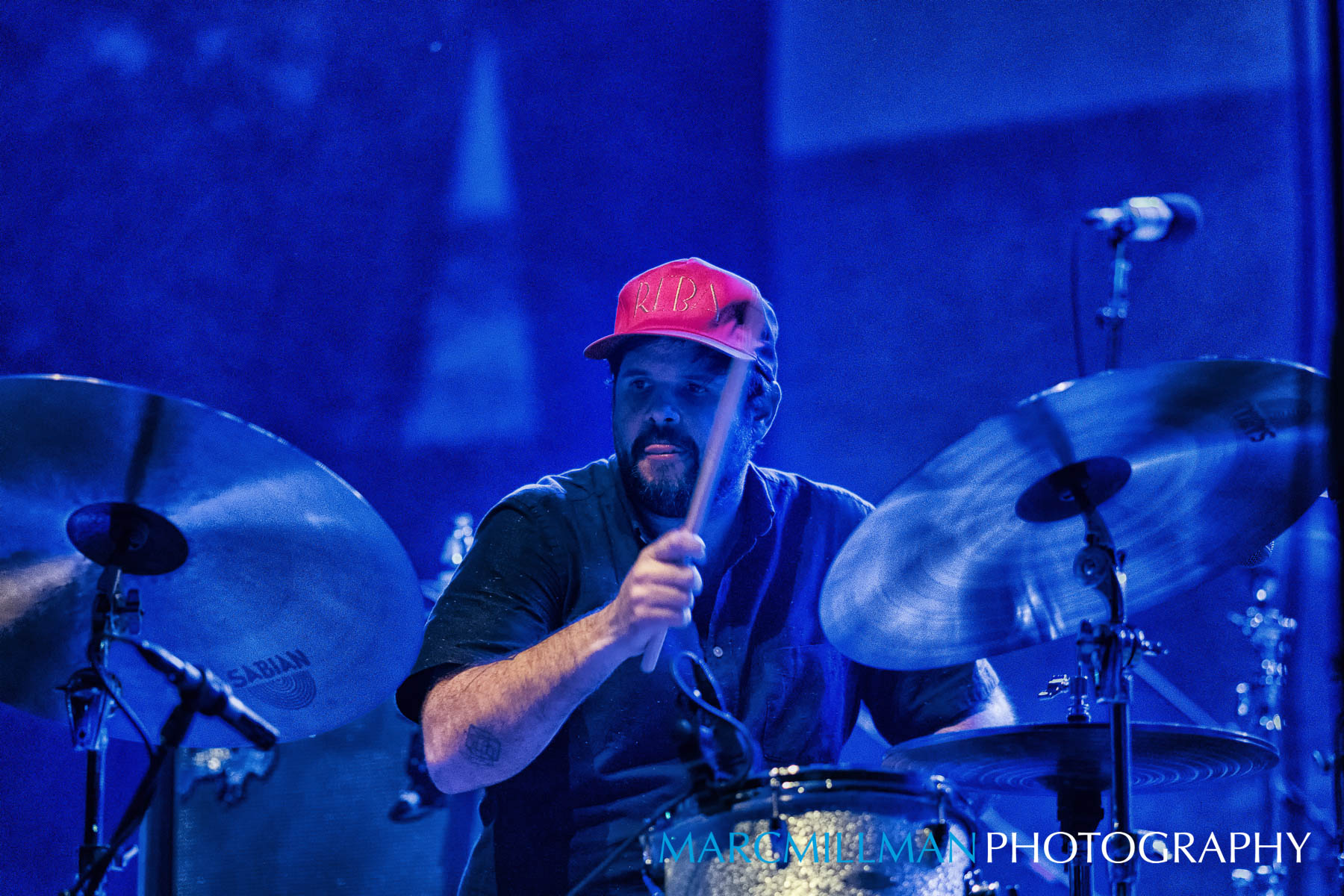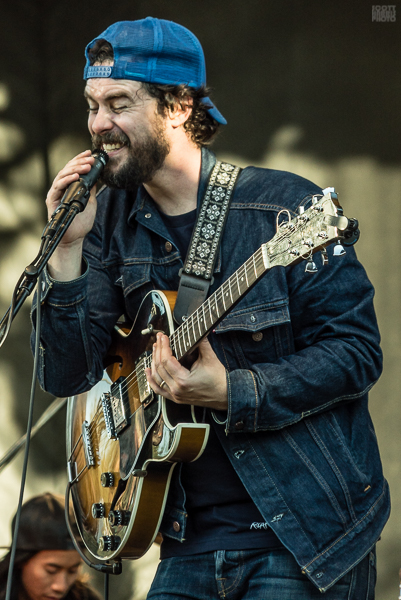White Denim’s Third Wind
 White Denim were just a few minutes into their sweaty Lockn’ set when their true interlocking moment took place. It was a hot, late August afternoon in Arrington, Va., and, despite their status as event newcomers and something of scene outliers, the Austin, Texas garage act already had a pretty good read on their festival crowd. So, with temperatures pushing toward 100, they brought out Joe Russo’s Almost Dead/WOLF! guitarist Scott Metzger for a run through the new boogie “Ha Ha Ha Ha (Yeah)” and their debut take on the Roxy Music Casablanca meditation “2HB.” Though it was the first time that Metzger, a mainstay of the jam community that helped seed Lockn’—thanks to his time with the turn-of-the-millennium Wetlands house band RANA—sat in with White Denim, the collaboration clicked. It also helped a band whose guitar heroics and progrock vamps have long been championed by the indie-rock community reach across the aisle to the Grateful Dead family that Lockn’ has catered to since its inception.
White Denim were just a few minutes into their sweaty Lockn’ set when their true interlocking moment took place. It was a hot, late August afternoon in Arrington, Va., and, despite their status as event newcomers and something of scene outliers, the Austin, Texas garage act already had a pretty good read on their festival crowd. So, with temperatures pushing toward 100, they brought out Joe Russo’s Almost Dead/WOLF! guitarist Scott Metzger for a run through the new boogie “Ha Ha Ha Ha (Yeah)” and their debut take on the Roxy Music Casablanca meditation “2HB.” Though it was the first time that Metzger, a mainstay of the jam community that helped seed Lockn’—thanks to his time with the turn-of-the-millennium Wetlands house band RANA—sat in with White Denim, the collaboration clicked. It also helped a band whose guitar heroics and progrock vamps have long been championed by the indie-rock community reach across the aisle to the Grateful Dead family that Lockn’ has catered to since its inception.
“We are having a good time with the music right now—we improvise inside of the arrangements we create for the stage,” guitarist James Petralli says a few weeks after that breakout set, which many considered to be a weekend highlight. “Solos are different in some tunes, and we are always messing with feels, but we are not ones to hang around in a vamp for too long.” 
While White Denim have specialized in subtle changes and lightning quick turns for a decade, their past year has been a time of personal reevaluation and sonic rediscovery. In March, the quartet released the Ethan Johns-produced LP Stiff on Downtown, their seventh album and first since guitarist Austin Jenkins and founding drummer Josh Block split with the band, following their work on R&B crooner Leon Bridges’ smash debut, Coming Home. Stiff also marks the first time that White Denim has enlisted a single outside producer for an entire recording process, which resulted in one of the group’s most retro-sounding releases and also perhaps their most fun and soulful. Both a rebirth and a bridge, Stiff features new guitarist Jonathan Horne and drummer Jeff Olson, veterans of Petralli’s Bop English solo project. However, as Petralli and longtime bassist Steve Terebecki have continued to fine-tune their sound throughout 2016, they’ve since reconfigured their band to instead include keyboardist/ trumpeter Mike St. Clair and drummer Jordan Richardson, a veteran of Ben Harper and Relentless7.
“The changes from night to night are probably fairly subtle to an audience,” Petralli admits. “We like to push ourselves physically and present an intense and tight show. We connect the tunes and kick the tempos up a few clicks for the stage.”
White Denim first crossed paths with Johns—whose credits include fellow modern roots acts like Ryan Adams, Kings of Leon and Ray LaMontagne, as well as legends like Paul McCartney, Tom Jones and Crosby, Stills and Nash—at a festival a few years ago and they immediately bonded. In the past, the group has favored self-production or working with multiple voices on their studio projects, but this time the band decided to hand over the reins and create a looser, more live-sounding record.
“We wanted to have a producer to take off some of the heat,” Petralli says. “In the past, it got a little confusing for us with the give and take of everybody producing together, so having a centralized guy in that leadership role was something we were interested in.”
The group stuck to their usual, organic formula, with Petralli crafting most of Stiff‘s verses, chords and lyrical changes and the rest of the band writing their parts and coming up with the arrangements as a unit. “If it sounds like the best Justin Bieber song ever, it’s definitely going to make the record,” Petralli says with a sly grin.
Terebecki, who is usually the second person to take a crack at the songs, thinks the record’s loose feel is a result of Johns’ decision to record Stiff live to 16-track. “We didn’t have a lot of opportunity to add a lot of overdubs,” he says. “So we played live as a four-piece and that’s how the record is, outside of a couple overdubs here and there.”
It’s a rainy April afternoon and Petralli and Terebecki are sitting at a high-top in a Lower East Side New York City bar next door to the indie-rock incubator Bowery Ballroom. They are both dressed in the same clothes they’ll sport onstage a few hours later. Petralli, whose father and grandfather both played professional baseball, is wearing a backward cap and a jean jacket with a pack of cigarettes tucked into his front pocket. Terebecki is in a fitted white shirt with some tie-dye flourishes.  White Denim is in the midst of a packed two-night run at the club, which has hosted several of the band’s career-defining shows in recent years. In 2013, they even played a double-header that stretched late into the night and, as much as anything, showcased their ability to harness the DIY energy of the city’s rowdy livemusic freaks. While picking at a plate of nachos, White Denim’s principal members are discussing their take on Steely Dan’s “Peg,” which is the first cover they’ve added to their repertoire. Terebecki says they adopted the song at the request of a Jimmy Kimmel Live! staffer who agreed to book the group if they learned the Steely Dan classic. Since then, they’ve also dropped in a Prince tribute medley. (Improv-rock troubadour, and the evening’s opening act, Sam Cohen sat in regularly on both selections throughout the tour and also introduced them to Metzger, who joined them for their Roxy Music nod.)
White Denim is in the midst of a packed two-night run at the club, which has hosted several of the band’s career-defining shows in recent years. In 2013, they even played a double-header that stretched late into the night and, as much as anything, showcased their ability to harness the DIY energy of the city’s rowdy livemusic freaks. While picking at a plate of nachos, White Denim’s principal members are discussing their take on Steely Dan’s “Peg,” which is the first cover they’ve added to their repertoire. Terebecki says they adopted the song at the request of a Jimmy Kimmel Live! staffer who agreed to book the group if they learned the Steely Dan classic. Since then, they’ve also dropped in a Prince tribute medley. (Improv-rock troubadour, and the evening’s opening act, Sam Cohen sat in regularly on both selections throughout the tour and also introduced them to Metzger, who joined them for their Roxy Music nod.)
White Denim has been the musicians’ primary musical outlet since 2005, when Terebecki’s band Peach Train shared a bill with fellow Austin act Parque Touch, which featured Block, Petralli and guitarist Lucas Anderson. Terebecki was invited to join Parque Touch and, after trying out a few different names, the group started gigging around their hometown as White Denim in 2006. (Anderson left the band to move to Russia.) They quickly settled on their signature blend of prog-rock technicality and loose, garagerock swagger. From the start, Petralli served as the band’s frontman, honing his bluesy voice to give the group’s songs weight, but with a delivery that still kept things fun enough to hint at his Frank Zappa obsession. The rhythm section of Terebecki and Block was equally dexterous, allowing the trio to move as a unit and spike their songbook with elements of jazz, psychedelia and ‘70s stoner rock. A few choice spots at SXSW, CMJ and, especially, Austin City Limits Music Festival, as well as their initial full-length release, Workout Holiday, introduced their punky yet experimental sound.
Petralli and Terebecki both note their ties to the improvisational world. Terebecki’s dad was a Dead fan who also listened to a lot of “prog and periphery jambands like Ozric Tentacles around the house,” he says.
His bandmate’s roots run even deeper. “I’ve always been a really big fan of Jerry Garcia as a guitar player, so I cop a lot of his moves,” Petralli says with a smile. “I had a good friend who could drive before me, and his older brother was really into [Widespread Panic’s] Space Wrangler, The Black Crowes, Traffic and classic rock. That’s all we would listen to. I saw Panic a couple times and smoked opium out of a deer antler at one of their shows—I was 17, so it was pretty informative, and I just got into smoking grass and listening to extended guitar solos. My senior year of high school, I saw Phish a bunch of times around Farmhouse.”
As his tastes changed, Petralli started digging into the Thrill Jockey catalog, falling under the spell of experimental post-rock acts like Tortoise and exploring good old-fashioned rock-and-roll. “I stepped away from the scene a little bit, but I always loved the studio records of the Grateful Dead,” Petralli says, pegging himself as a child of the modern jamband era. “The more time I spend in the studio, the more I love those records and appreciate what they accomplished from a production and writing standpoint. Those are still some of the most creative recordings ever made.”
White Denim entered their second act in 2010 when they expanded their lineup to include Jenkins, a student of country-rock and a descendent of the Allman Brothers Band’s twin-guitar harmonies, and the newly minted foursome expanded their sonic palette. Their 2011 release, D, tilted the group’s sound toward their prog and psych-rock influences and wove in acoustic elements and other studio layers. Terebecki says their new lineup, which allowed them to push their instrumental sections and melodies to the limit, helped the band “cross over a bit” into the jamband scene.
“Yes was the big touchstone for that record,” Petralli says. “And I snuck little partial quotes of ‘St. Stephen’ and little nuggets in there for Deadheads—we were improvising more with our vamping and stuff like that in a few spots.”
They moved further into the live music world with 2013’s Corsicana Lemonade, their first album with Jenkins fully integrated into the band. Teaming up with Jeff Tweedy— who opened up Wilco’s fabled Loft studio to the group—on some tracks and Spoon/ White Rabbits producer Jim Vollentine on others, White Denim laid out a kaleidoscopic mix of Southern rock, blues, roots-rock and elastic garage-burners primed for festival slots, which the band started landing at Bonnaroo, Mountain Jam and Solid Sound. “With D, I stacked up all these guitars and, after Austin joined, we added even more guitars,” Petralli says with a laugh as he thinks back on their “power-chord period.” “There are tracks on that record that have 10 guitars.”
Despite their gradual rise through the marquee club circuit that has become the live music world’s bedrock in recent years, White Denim’s career took a sudden left turn when Jenkins met Leon Bridges at a Fort Worth, Texas bar during the summer of 2014. Bridges was completely unknown at the time—working at a restaurant and testing out his brand of vintage soul during a weekly open mic night—when Jenkins’ girlfriend approached him. Her opening line was that Bridges had the same vintage Wrangler jeans as Jenkins.
“When I met Austin at that bar that night, I didn’t know who the hell he was,” Bridges says with a laugh. “It wasn’t until after he left that the bartender was like, ‘You know that was Austin Jenkins of White Denim.’ The funny thing is I had first heard of White Denim a week before I met Austin. I didn’t know any of the guys yet, but they had just played a show at Shipping & Receiving and everyone was going crazy about them.”
Bridges considers that night the start of his “rags to riches story.” Soon after, Jenkins brought Bridges into the studio to record a few tracks with some of his musical associates, including Block. White Denim’s managers signed Bridges and, thanks to an authentic, retro-sounding voice which eerily recalls Sam Cooke, he blossomed into a grassroots sensation. Less than a year after his album hit in mid-2015, Bridges had already been invited to the White House, nominated for a Grammy and sold out prestigious theaters across the country.
Block and Jenkins played their last show with White Denim in October of 2014. The band had initially scheduled some time off while Terebecki prepared for the birth of his daughter and Block and Jenkins recorded with Bridges.
 “It happened really quickly for them,” Petralli says of Bridges’ rapid rise. “We said, ‘We’re going to take some time off, but let’s get together and write in a month or whatever,’ and they went on tour with Leon. Communication wasn’t super great and there was so much happening with us personally that it was kind of like, ‘Huh, I wonder what’s going on?’”
“It happened really quickly for them,” Petralli says of Bridges’ rapid rise. “We said, ‘We’re going to take some time off, but let’s get together and write in a month or whatever,’ and they went on tour with Leon. Communication wasn’t super great and there was so much happening with us personally that it was kind of like, ‘Huh, I wonder what’s going on?’”
But the writing was on the wall. Around February 2015, with Bridges’ star rising in advance of his Columbia debut, Jenkins and Block left to focus on Bridges and other production work. (They also recently recorded Nicole Atkins.)
“They were going to be touring forever,” Terebecki says. “We were like, ‘We really need to get in there and make another record—we can’t wait for you guys to tour.’ It was around March where we started to figure something else out.”
Petralli and Terebecki regrouped to work on Stiff in mid-2015. Around the same time, Petralli was gearing up to release his first solo album under the moniker Bop English (the pseudonym he used in White Denim’s early days). The side project started as an outlet for Petralli to unveil a handful of songs he’d been working on for a few years that had yet to see the light of day. The resulting collection, Constant Bop, still falls very much in White Denim’s sonic, genre-defying orbit; Block plays drums on the album while Terebecki provides some samples. “With White Denim, it’s important for us to work on the music together,” the guitarist says of his extracurricular activities. “It was just a studio project I was doing in my spare time. I had no intention of putting a band together—the band forming was actually a reaction to feeling like we were going to have some time between getting a new White Denim together. I just really wanted to produce a record on my own, so it was more about that than anything.”
Petralli says Constant Bop had been finished and ready to ship as soon as White Denim had a little breathing room, but with the lineup changes, he decided to use the project to test out a new version of White Denim and hit the road. He assembled a live version of Bop English featuring Terebecki on keys, along with Horne and Olson. “With the guys quitting, I just needed to get White Denim together,” he admits. “That’s our bread and butter, so we just ditched it. I thought, ‘I can’t really justify doing this when there’s an opportunity to continue White Denim.’” The Bop English tour went well and they rolled that energy into a new White Denim lineup.
White Denim live-tracked decent portions of their past few albums, but, with Stiff, they decided to forego the ‘studio as an instrument’ approach almost entirely. With Johns at the helm, they settled on a mix of sexy Curtis Mayfield-influenced chestnuts like “Ha Ha Ha Ha (Yeah)” and “Take It Easy (Ever After Lasting Love),” ‘70s rockers such as “Real Deal Momma,” “Had 2 Know (Personal)” and “Holda You (I’m Psycho),” and the power-pop of “There’s a Brain in My Head.” They focused less on big chords and more on grooves, resulting in slow jams like the funky “(I’m the One) Big Big Fun” and the modern, psychedelic soul closer “Thank You.” A number of influences seeped in, including Texas guitar player Nitzinger, English hard rockers Necromandus, Tame Impala, Dungen, overthe-top R&B and R. Kelly. Both of their new members were already well-versed in the band’s catalog by the time they entered rehearsals. They met Olson, a jazz-trained drummer, at a White Denim show when he was 19. But despite the lineup changes, Stiff still feels very much like White Denim.

“To be completely honest, I was really nervous about how people would perceive the new band, just because we started the group together a long time ago and we had a lot of chemistry,” Petralli says. “I’d been playing with Josh since I started playing guitar at 17 years old, so I was really concerned how it would play out without them. But every day that goes by, this band gets better and I feel much better about it.”
The new White Denim lineup started revisiting their back-catalog, playing early tunes first and working up to more recent tunes. Their spring and summer tours featured a healthy mix of material from each of the outfit’s eras, and Petralli says their drummer was particularly drawn to songs with odd meters that “weren’t under a time signature.”
They cherry-picked tracks that worked for the evolving group and refashioned some tunes with fresh jungle beats. They also added St. Clair, whom they plucked from a local steel player. “We’ve always wanted to have a keyboardist in the band because we have so many keyboards on the record, and we can finally play some of those old tunes like ‘Sex Prayer’ and ‘Sitting,’” Terebecki says. Throughout the spring, Petralli admits the group was still “feeling each other out a little bit, so it’s definitely going back to the old way of doing it—we’re still doing medleys and stitching a lot of tunes together, but with a more rocky energy, a more hard-hitting kind of thing.”
Richardson joined White Denim this summer and has already helped push the sound to new heights. “Jordan played on a session that Steve and I were on and we hit it off quickly,” Petralli explains. “We have similar tastes in music and seem to share artistic goals. He is also really funny and easy to be around. We are really happy to have him.”
White Denim remain committed to expanding their sound as they continue to gel onstage. Petralli will also continue to revisit his roots when he participates in The Complete Last Waltz, a Thanksgiving Eve tribute to The Band, featuring Cohen, Wilco’s Nels Cline and the members of Joe Russo’s Almost Dead, among others, at Port Chester, N.Y.’s Capitol Theatre. He sees that scene’s loose feel creeping back into their sound.
“We are jamming tons in the studio and in soundchecks,” he says. “Having new musicians in the mix has been really good for the music. I’m personally feeling more open and inspired than I have in years.”



















